NRSG367, Semester 1, 2020: Medication Safety Incident Reflection
VerifiedAdded on 2022/08/13
|6
|1546
|17
Report
AI Summary
This report presents a critical reflection on a medication error experienced during a clinical placement in a cardiac ward. The incident involved a nurse administering oxycodone to the wrong patient, who was also allergic to the medication. The reflection analyzes the event using the Gibbs reflective cycle, focusing on the failure to adhere to the seven rights of medication administration and the violation of National Safety and Quality Health Service (NSQHS) standards. The report details the patient's adverse reaction, the importance of recognizing allergies and contraindications, and the significance of accurate patient identification. It discusses the role of the Medical Emergency Team (MET) and the need for thorough medication reviews. The reflection emphasizes the importance of following best practices, learning from mistakes, and preventing future errors. The student highlights the need for diligent adherence to medication safety protocols to ensure patient safety and improve nursing practice. The report also references relevant research and literature on patient misidentification and medication errors.
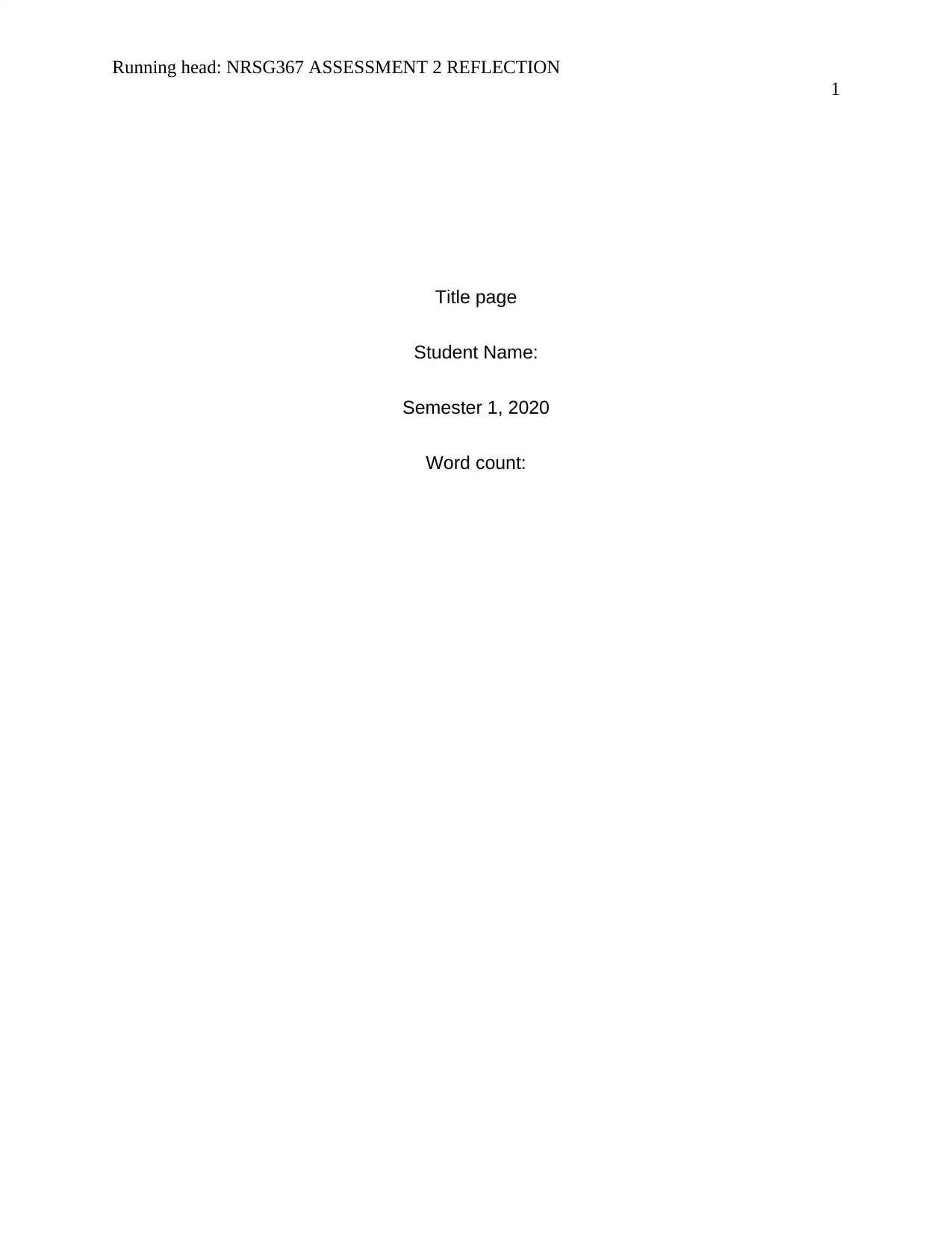
Running head: NRSG367 ASSESSMENT 2 REFLECTION
1
Title page
Student Name:
Semester 1, 2020
Word count:
1
Title page
Student Name:
Semester 1, 2020
Word count:
Paraphrase This Document
Need a fresh take? Get an instant paraphrase of this document with our AI Paraphraser
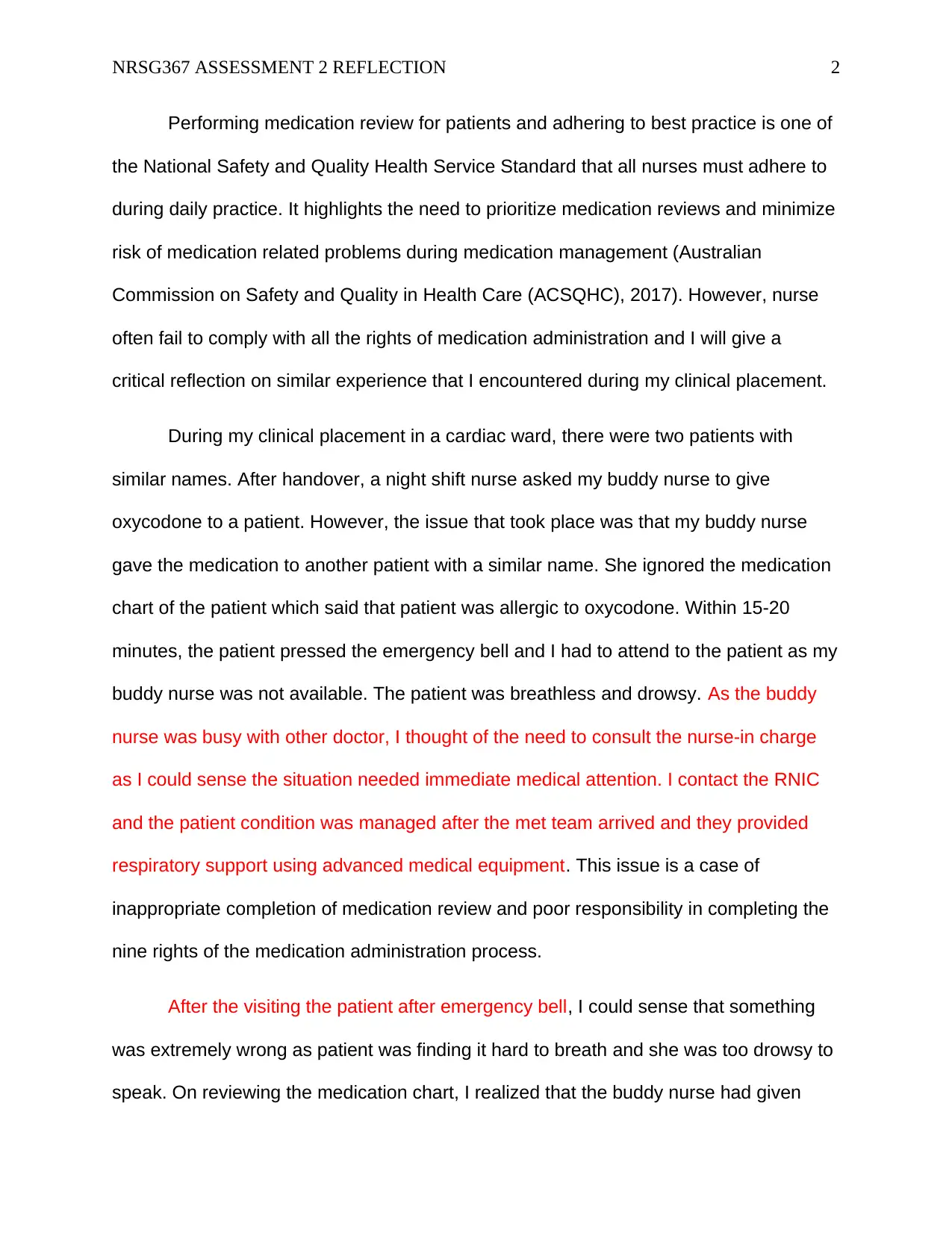
NRSG367 ASSESSMENT 2 REFLECTION 2
Performing medication review for patients and adhering to best practice is one of
the National Safety and Quality Health Service Standard that all nurses must adhere to
during daily practice. It highlights the need to prioritize medication reviews and minimize
risk of medication related problems during medication management (Australian
Commission on Safety and Quality in Health Care (ACSQHC), 2017). However, nurse
often fail to comply with all the rights of medication administration and I will give a
critical reflection on similar experience that I encountered during my clinical placement.
During my clinical placement in a cardiac ward, there were two patients with
similar names. After handover, a night shift nurse asked my buddy nurse to give
oxycodone to a patient. However, the issue that took place was that my buddy nurse
gave the medication to another patient with a similar name. She ignored the medication
chart of the patient which said that patient was allergic to oxycodone. Within 15-20
minutes, the patient pressed the emergency bell and I had to attend to the patient as my
buddy nurse was not available. The patient was breathless and drowsy. As the buddy
nurse was busy with other doctor, I thought of the need to consult the nurse-in charge
as I could sense the situation needed immediate medical attention. I contact the RNIC
and the patient condition was managed after the met team arrived and they provided
respiratory support using advanced medical equipment. This issue is a case of
inappropriate completion of medication review and poor responsibility in completing the
nine rights of the medication administration process.
After the visiting the patient after emergency bell, I could sense that something
was extremely wrong as patient was finding it hard to breath and she was too drowsy to
speak. On reviewing the medication chart, I realized that the buddy nurse had given
Performing medication review for patients and adhering to best practice is one of
the National Safety and Quality Health Service Standard that all nurses must adhere to
during daily practice. It highlights the need to prioritize medication reviews and minimize
risk of medication related problems during medication management (Australian
Commission on Safety and Quality in Health Care (ACSQHC), 2017). However, nurse
often fail to comply with all the rights of medication administration and I will give a
critical reflection on similar experience that I encountered during my clinical placement.
During my clinical placement in a cardiac ward, there were two patients with
similar names. After handover, a night shift nurse asked my buddy nurse to give
oxycodone to a patient. However, the issue that took place was that my buddy nurse
gave the medication to another patient with a similar name. She ignored the medication
chart of the patient which said that patient was allergic to oxycodone. Within 15-20
minutes, the patient pressed the emergency bell and I had to attend to the patient as my
buddy nurse was not available. The patient was breathless and drowsy. As the buddy
nurse was busy with other doctor, I thought of the need to consult the nurse-in charge
as I could sense the situation needed immediate medical attention. I contact the RNIC
and the patient condition was managed after the met team arrived and they provided
respiratory support using advanced medical equipment. This issue is a case of
inappropriate completion of medication review and poor responsibility in completing the
nine rights of the medication administration process.
After the visiting the patient after emergency bell, I could sense that something
was extremely wrong as patient was finding it hard to breath and she was too drowsy to
speak. On reviewing the medication chart, I realized that the buddy nurse had given
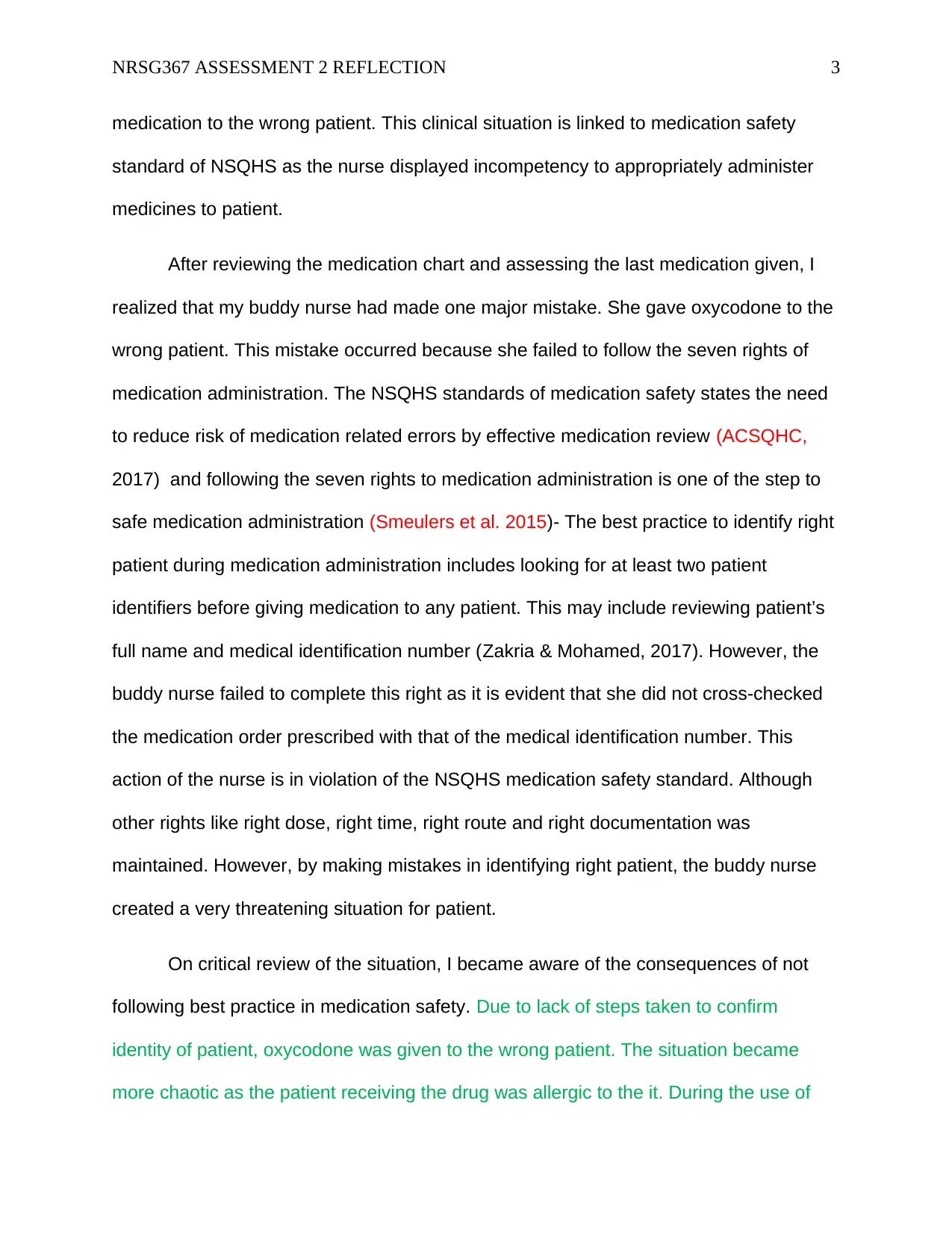
NRSG367 ASSESSMENT 2 REFLECTION 3
medication to the wrong patient. This clinical situation is linked to medication safety
standard of NSQHS as the nurse displayed incompetency to appropriately administer
medicines to patient.
After reviewing the medication chart and assessing the last medication given, I
realized that my buddy nurse had made one major mistake. She gave oxycodone to the
wrong patient. This mistake occurred because she failed to follow the seven rights of
medication administration. The NSQHS standards of medication safety states the need
to reduce risk of medication related errors by effective medication review (ACSQHC,
2017) and following the seven rights to medication administration is one of the step to
safe medication administration (Smeulers et al. 2015)- The best practice to identify right
patient during medication administration includes looking for at least two patient
identifiers before giving medication to any patient. This may include reviewing patient’s
full name and medical identification number (Zakria & Mohamed, 2017). However, the
buddy nurse failed to complete this right as it is evident that she did not cross-checked
the medication order prescribed with that of the medical identification number. This
action of the nurse is in violation of the NSQHS medication safety standard. Although
other rights like right dose, right time, right route and right documentation was
maintained. However, by making mistakes in identifying right patient, the buddy nurse
created a very threatening situation for patient.
On critical review of the situation, I became aware of the consequences of not
following best practice in medication safety. Due to lack of steps taken to confirm
identity of patient, oxycodone was given to the wrong patient. The situation became
more chaotic as the patient receiving the drug was allergic to the it. During the use of
medication to the wrong patient. This clinical situation is linked to medication safety
standard of NSQHS as the nurse displayed incompetency to appropriately administer
medicines to patient.
After reviewing the medication chart and assessing the last medication given, I
realized that my buddy nurse had made one major mistake. She gave oxycodone to the
wrong patient. This mistake occurred because she failed to follow the seven rights of
medication administration. The NSQHS standards of medication safety states the need
to reduce risk of medication related errors by effective medication review (ACSQHC,
2017) and following the seven rights to medication administration is one of the step to
safe medication administration (Smeulers et al. 2015)- The best practice to identify right
patient during medication administration includes looking for at least two patient
identifiers before giving medication to any patient. This may include reviewing patient’s
full name and medical identification number (Zakria & Mohamed, 2017). However, the
buddy nurse failed to complete this right as it is evident that she did not cross-checked
the medication order prescribed with that of the medical identification number. This
action of the nurse is in violation of the NSQHS medication safety standard. Although
other rights like right dose, right time, right route and right documentation was
maintained. However, by making mistakes in identifying right patient, the buddy nurse
created a very threatening situation for patient.
On critical review of the situation, I became aware of the consequences of not
following best practice in medication safety. Due to lack of steps taken to confirm
identity of patient, oxycodone was given to the wrong patient. The situation became
more chaotic as the patient receiving the drug was allergic to the it. During the use of
⊘ This is a preview!⊘
Do you want full access?
Subscribe today to unlock all pages.

Trusted by 1+ million students worldwide
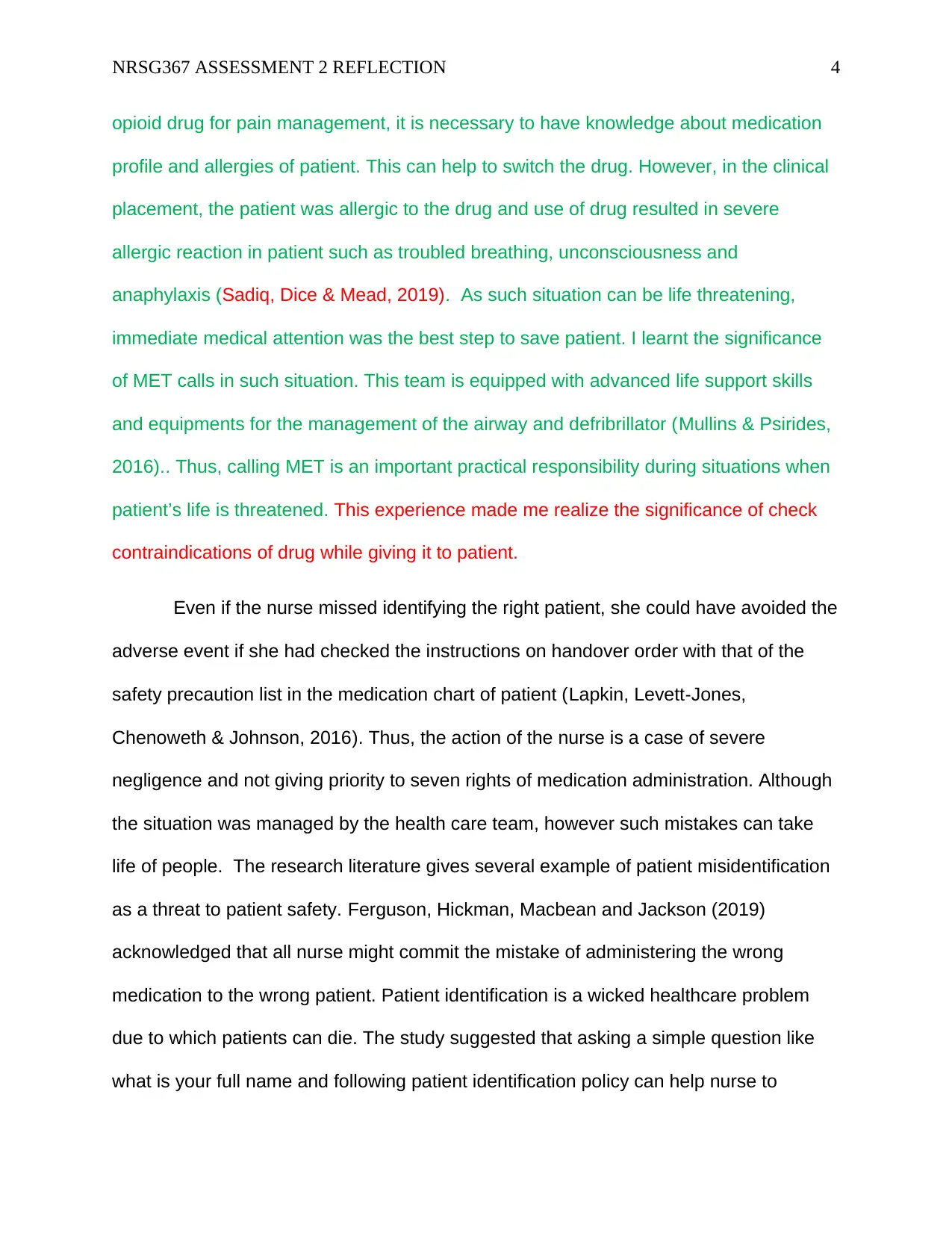
NRSG367 ASSESSMENT 2 REFLECTION 4
opioid drug for pain management, it is necessary to have knowledge about medication
profile and allergies of patient. This can help to switch the drug. However, in the clinical
placement, the patient was allergic to the drug and use of drug resulted in severe
allergic reaction in patient such as troubled breathing, unconsciousness and
anaphylaxis (Sadiq, Dice & Mead, 2019). As such situation can be life threatening,
immediate medical attention was the best step to save patient. I learnt the significance
of MET calls in such situation. This team is equipped with advanced life support skills
and equipments for the management of the airway and defribrillator (Mullins & Psirides,
2016).. Thus, calling MET is an important practical responsibility during situations when
patient’s life is threatened. This experience made me realize the significance of check
contraindications of drug while giving it to patient.
Even if the nurse missed identifying the right patient, she could have avoided the
adverse event if she had checked the instructions on handover order with that of the
safety precaution list in the medication chart of patient (Lapkin, Levett‐Jones,
Chenoweth & Johnson, 2016). Thus, the action of the nurse is a case of severe
negligence and not giving priority to seven rights of medication administration. Although
the situation was managed by the health care team, however such mistakes can take
life of people. The research literature gives several example of patient misidentification
as a threat to patient safety. Ferguson, Hickman, Macbean and Jackson (2019)
acknowledged that all nurse might commit the mistake of administering the wrong
medication to the wrong patient. Patient identification is a wicked healthcare problem
due to which patients can die. The study suggested that asking a simple question like
what is your full name and following patient identification policy can help nurse to
opioid drug for pain management, it is necessary to have knowledge about medication
profile and allergies of patient. This can help to switch the drug. However, in the clinical
placement, the patient was allergic to the drug and use of drug resulted in severe
allergic reaction in patient such as troubled breathing, unconsciousness and
anaphylaxis (Sadiq, Dice & Mead, 2019). As such situation can be life threatening,
immediate medical attention was the best step to save patient. I learnt the significance
of MET calls in such situation. This team is equipped with advanced life support skills
and equipments for the management of the airway and defribrillator (Mullins & Psirides,
2016).. Thus, calling MET is an important practical responsibility during situations when
patient’s life is threatened. This experience made me realize the significance of check
contraindications of drug while giving it to patient.
Even if the nurse missed identifying the right patient, she could have avoided the
adverse event if she had checked the instructions on handover order with that of the
safety precaution list in the medication chart of patient (Lapkin, Levett‐Jones,
Chenoweth & Johnson, 2016). Thus, the action of the nurse is a case of severe
negligence and not giving priority to seven rights of medication administration. Although
the situation was managed by the health care team, however such mistakes can take
life of people. The research literature gives several example of patient misidentification
as a threat to patient safety. Ferguson, Hickman, Macbean and Jackson (2019)
acknowledged that all nurse might commit the mistake of administering the wrong
medication to the wrong patient. Patient identification is a wicked healthcare problem
due to which patients can die. The study suggested that asking a simple question like
what is your full name and following patient identification policy can help nurse to
Paraphrase This Document
Need a fresh take? Get an instant paraphrase of this document with our AI Paraphraser
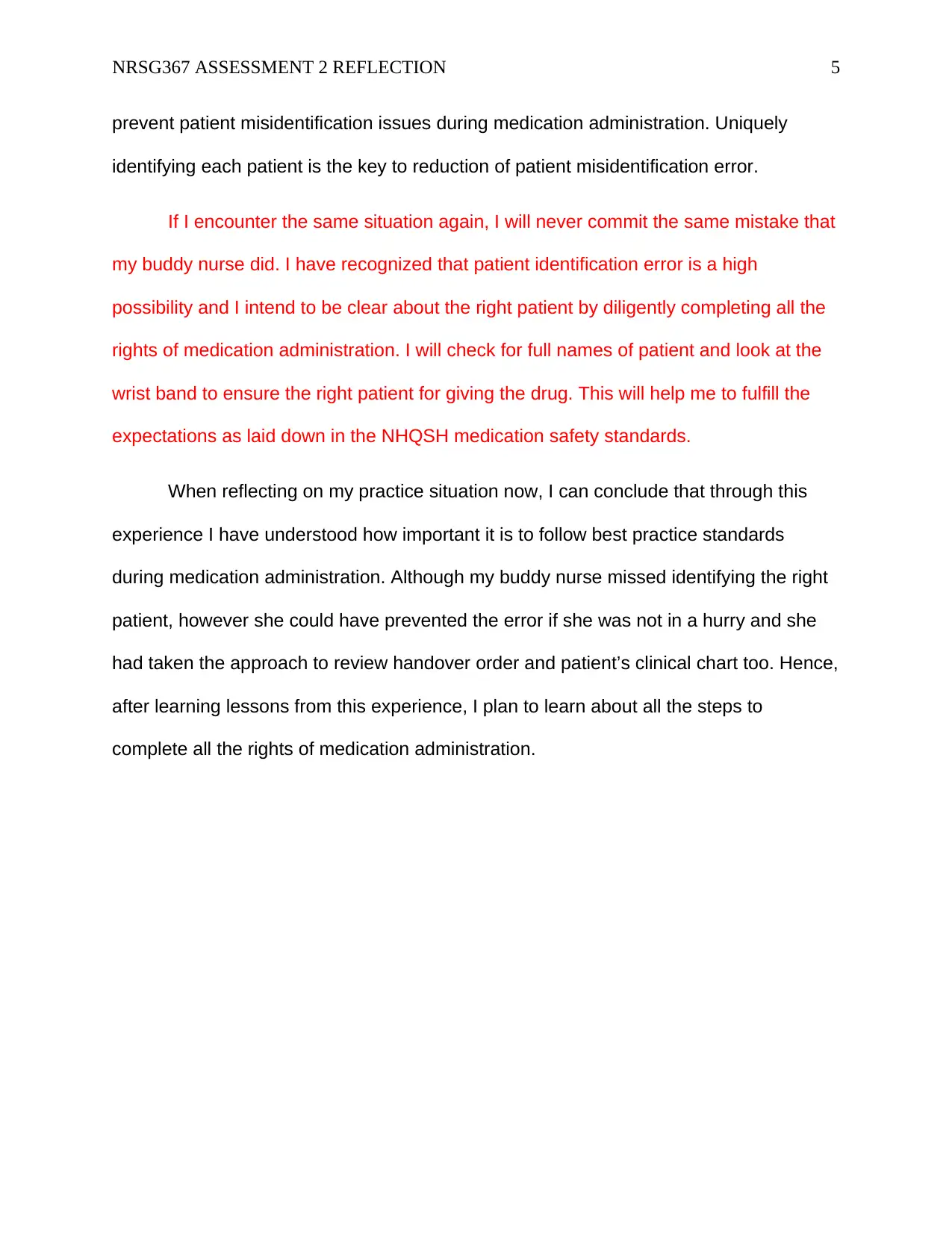
NRSG367 ASSESSMENT 2 REFLECTION 5
prevent patient misidentification issues during medication administration. Uniquely
identifying each patient is the key to reduction of patient misidentification error.
If I encounter the same situation again, I will never commit the same mistake that
my buddy nurse did. I have recognized that patient identification error is a high
possibility and I intend to be clear about the right patient by diligently completing all the
rights of medication administration. I will check for full names of patient and look at the
wrist band to ensure the right patient for giving the drug. This will help me to fulfill the
expectations as laid down in the NHQSH medication safety standards.
When reflecting on my practice situation now, I can conclude that through this
experience I have understood how important it is to follow best practice standards
during medication administration. Although my buddy nurse missed identifying the right
patient, however she could have prevented the error if she was not in a hurry and she
had taken the approach to review handover order and patient’s clinical chart too. Hence,
after learning lessons from this experience, I plan to learn about all the steps to
complete all the rights of medication administration.
prevent patient misidentification issues during medication administration. Uniquely
identifying each patient is the key to reduction of patient misidentification error.
If I encounter the same situation again, I will never commit the same mistake that
my buddy nurse did. I have recognized that patient identification error is a high
possibility and I intend to be clear about the right patient by diligently completing all the
rights of medication administration. I will check for full names of patient and look at the
wrist band to ensure the right patient for giving the drug. This will help me to fulfill the
expectations as laid down in the NHQSH medication safety standards.
When reflecting on my practice situation now, I can conclude that through this
experience I have understood how important it is to follow best practice standards
during medication administration. Although my buddy nurse missed identifying the right
patient, however she could have prevented the error if she was not in a hurry and she
had taken the approach to review handover order and patient’s clinical chart too. Hence,
after learning lessons from this experience, I plan to learn about all the steps to
complete all the rights of medication administration.
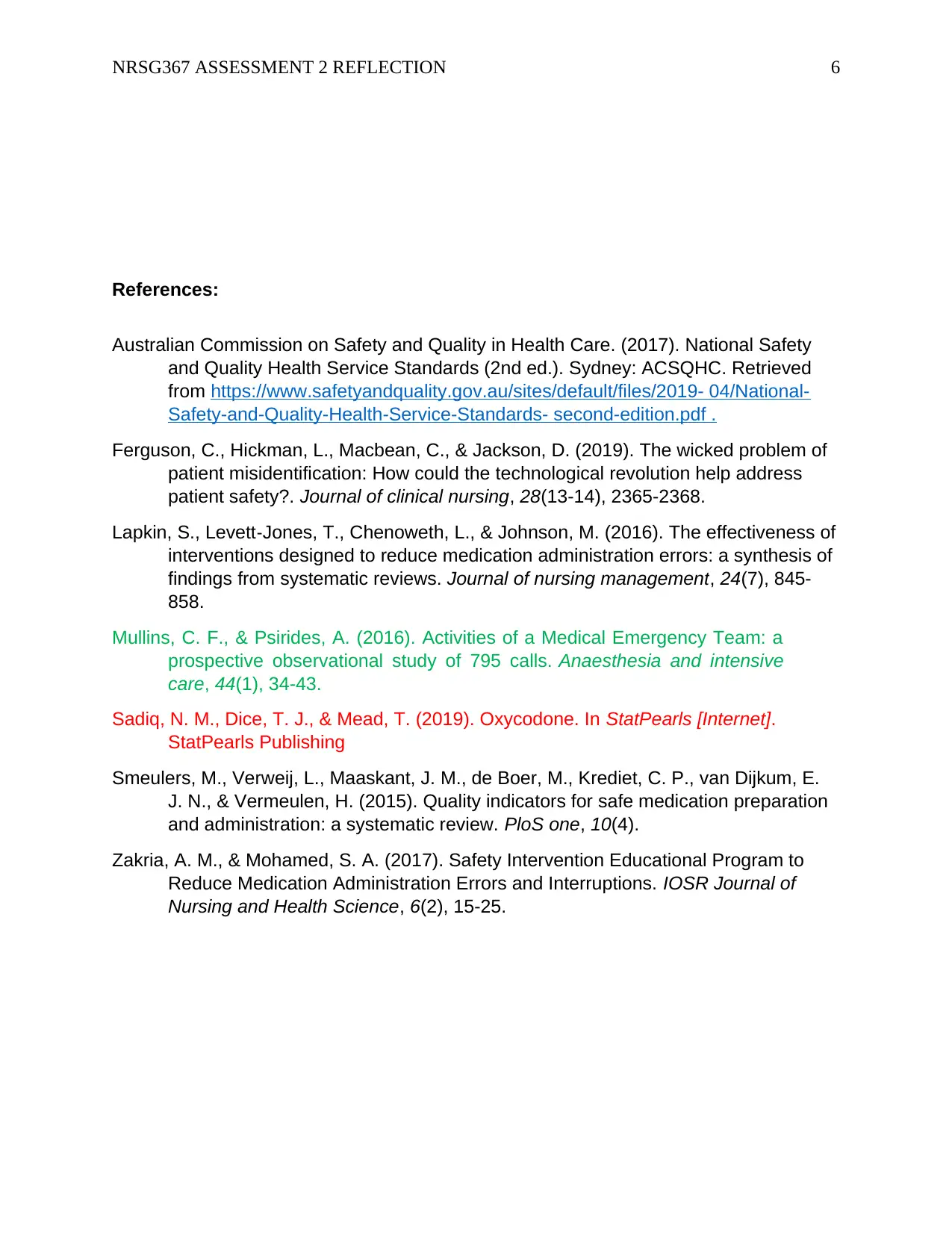
NRSG367 ASSESSMENT 2 REFLECTION 6
References:
Australian Commission on Safety and Quality in Health Care. (2017). National Safety
and Quality Health Service Standards (2nd ed.). Sydney: ACSQHC. Retrieved
from https://www.safetyandquality.gov.au/sites/default/files/2019- 04/National-
Safety-and-Quality-Health-Service-Standards- second-edition.pdf .
Ferguson, C., Hickman, L., Macbean, C., & Jackson, D. (2019). The wicked problem of
patient misidentification: How could the technological revolution help address
patient safety?. Journal of clinical nursing, 28(13-14), 2365-2368.
Lapkin, S., Levett‐Jones, T., Chenoweth, L., & Johnson, M. (2016). The effectiveness of
interventions designed to reduce medication administration errors: a synthesis of
findings from systematic reviews. Journal of nursing management, 24(7), 845-
858.
Mullins, C. F., & Psirides, A. (2016). Activities of a Medical Emergency Team: a
prospective observational study of 795 calls. Anaesthesia and intensive
care, 44(1), 34-43.
Sadiq, N. M., Dice, T. J., & Mead, T. (2019). Oxycodone. In StatPearls [Internet].
StatPearls Publishing
Smeulers, M., Verweij, L., Maaskant, J. M., de Boer, M., Krediet, C. P., van Dijkum, E.
J. N., & Vermeulen, H. (2015). Quality indicators for safe medication preparation
and administration: a systematic review. PloS one, 10(4).
Zakria, A. M., & Mohamed, S. A. (2017). Safety Intervention Educational Program to
Reduce Medication Administration Errors and Interruptions. IOSR Journal of
Nursing and Health Science, 6(2), 15-25.
References:
Australian Commission on Safety and Quality in Health Care. (2017). National Safety
and Quality Health Service Standards (2nd ed.). Sydney: ACSQHC. Retrieved
from https://www.safetyandquality.gov.au/sites/default/files/2019- 04/National-
Safety-and-Quality-Health-Service-Standards- second-edition.pdf .
Ferguson, C., Hickman, L., Macbean, C., & Jackson, D. (2019). The wicked problem of
patient misidentification: How could the technological revolution help address
patient safety?. Journal of clinical nursing, 28(13-14), 2365-2368.
Lapkin, S., Levett‐Jones, T., Chenoweth, L., & Johnson, M. (2016). The effectiveness of
interventions designed to reduce medication administration errors: a synthesis of
findings from systematic reviews. Journal of nursing management, 24(7), 845-
858.
Mullins, C. F., & Psirides, A. (2016). Activities of a Medical Emergency Team: a
prospective observational study of 795 calls. Anaesthesia and intensive
care, 44(1), 34-43.
Sadiq, N. M., Dice, T. J., & Mead, T. (2019). Oxycodone. In StatPearls [Internet].
StatPearls Publishing
Smeulers, M., Verweij, L., Maaskant, J. M., de Boer, M., Krediet, C. P., van Dijkum, E.
J. N., & Vermeulen, H. (2015). Quality indicators for safe medication preparation
and administration: a systematic review. PloS one, 10(4).
Zakria, A. M., & Mohamed, S. A. (2017). Safety Intervention Educational Program to
Reduce Medication Administration Errors and Interruptions. IOSR Journal of
Nursing and Health Science, 6(2), 15-25.
⊘ This is a preview!⊘
Do you want full access?
Subscribe today to unlock all pages.

Trusted by 1+ million students worldwide
1 out of 6
Related Documents
Your All-in-One AI-Powered Toolkit for Academic Success.
+13062052269
info@desklib.com
Available 24*7 on WhatsApp / Email
![[object Object]](/_next/static/media/star-bottom.7253800d.svg)
Unlock your academic potential
Copyright © 2020–2025 A2Z Services. All Rights Reserved. Developed and managed by ZUCOL.





